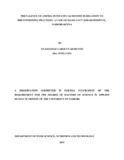| dc.description.abstract | Although studies have been carried out on breastfeeding and supplementary feeding of infants,
so far, little information exist on the relationship between breastfeeding practices and the
development of anemia in infants. This study was therefore designed to assess the association
between breastfeeding type, maternal iron status and other associated factors on hemoglobin
concentration in the blood of 3-6 months old infants.
The study was cross sectional survey involving both descriptive and analytical components. The
study was conducted at Maternal and Child health clinic in Mama Lucy Kibaki Hospital in
Nairobi and targeted 3-6 months old infants. A previously pretested structured questionnaire was
administered to collect socio-demographics and socio-economic characteristics of the household,
infant feeding practices, morbidity, their nutritional status and anthropometry of the mothers.
Results were analyzed using Chi-square test and linear regression to determine the difference
between proportions and odds ratios to estimate the relative risk. The statistical analyses were
carried out using the Statistical Package for the Social Sciences (SPSS), version 12.
In total, 250 mother infant dyads participated in the study. Majority (91.5. %) of the respondents
were aged 20-35, years while only 4.5% were 19 years and below and 4% aged between 36-45
years. The mean age of the mothers was 26.53 with a range of 15-45 years. The mean household
size was 4.3 members and the national average mean household size is 4.6 for urban areas. The
dependency ratio was 74. Among the infants studied, 52% were males and 48.0% were females.
The greatest share of the infants were aged 5 months (38 %) followed by those aged 4 months
(36%) then those who were aged 3 months (26%). The mean age of the infants was 4.12 ranging
from 3-6 months.
The prevalence of exclusive breastfeeding was 57.0% among the infants followed by those who
were partially breastfed at 38% then those who were mixed breastfed at 4.8%. The birth weight
of the infant, anemia experiences of the mother during pregnancy and sickness in the past two
weeks were significantly (p<0.05) associated with the breastfeeding type.
The rates of under nutrition were low with wasting at 1.2% underweight at 2.0% and stunting at
11.2%. Of the stunted children, 10.4% were moderately stunted and 0.8% severely stunted.
Growth pattern and stunting were found to be significantly (p<0.05) associated with marital status of mothers, birth order, sex, birth weight and weaning age of the infant. Up to 96.3% of
the infants had been immunized completely for their age.
The mean weight of the mothers at delivery was 72.6 kg, with a range of 50-106 kg, while the
mean weight obtained at the time of data collection was 67.4 kg with a range of 43.2-115kg.
Their mean height was 1.59 m with a range of 1.45-1.71m. Up to 43.5% of the mothers were
overweight and 37.5% had normal weight. Most women (76%) took the Iron and Folic acid
supplementation with 35% taking the supplements for one or two months, 24% for 3 or 4 months
and 12% for 5 or 6 months. The mean hemoglobin level of mothers during pregnancy was 11.9
g/dl with a range of 9-14.3 g/dl. The prevalence of moderate and mild anemia during pregnancy
was 15.5% and 5.5% respectively with no reported cases of severe anemia.
The mean prevalence of anemia in the infants was at 54.5%, with 32.5% mild 22.5% moderate
and 0.5% severe. The mean hemoglobin level was 10.7 g/dL. Low birth weight (P=0.029),
maternal iron supplementation during pregnancy (P=0.023), infant sickness in the preceding two
weeks prior to the survey (P=0.02) and breastfeeding practices (OR=1•46; 95 %=1.3, 2.6,
P=0•04) were significantly associated with anemia in infants.
Of the infants, 42.5% had experienced sickness two weeks preceding the survey of which 38.0%
sought medical intervention.
The study concludes that exclusively breastfed infants are at a higher risk of developing iron
deficiency anemia as compared to those who are introduced to complementary feeds earlier than
six months and those given infant formulas alongside breast milk. | en_US |

